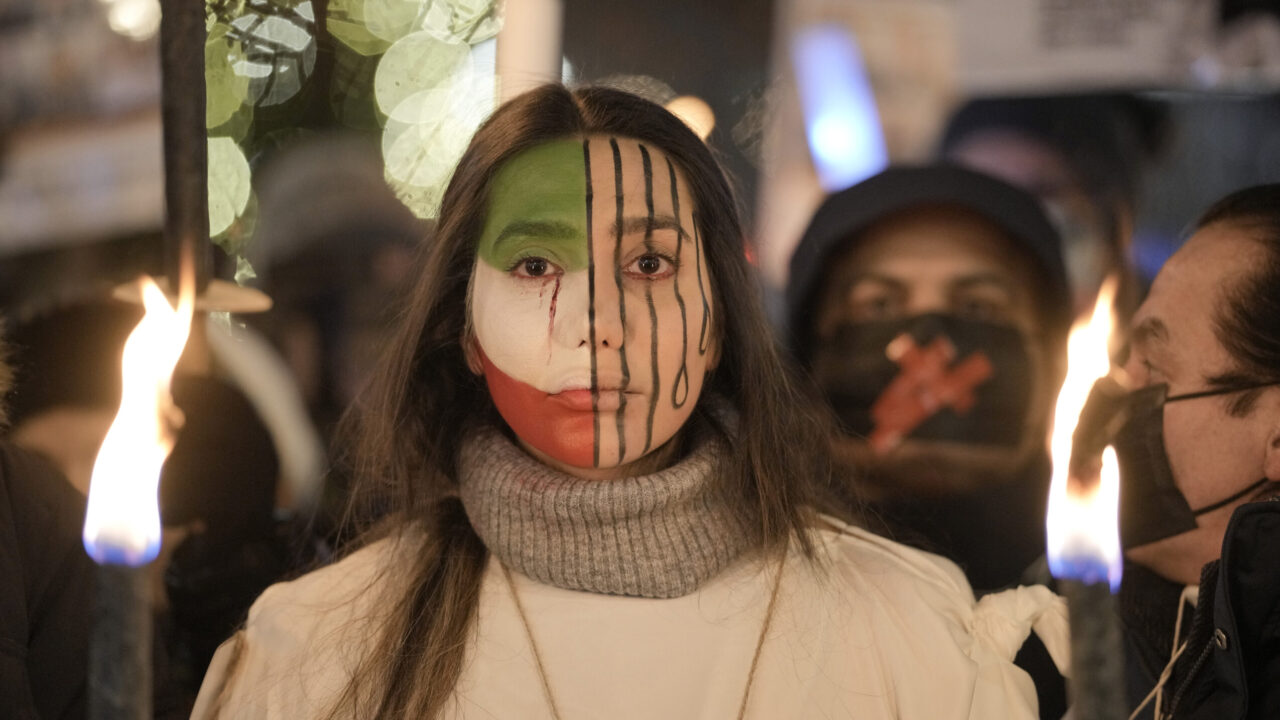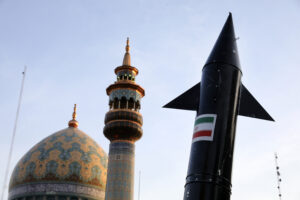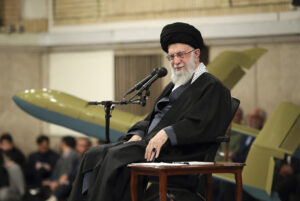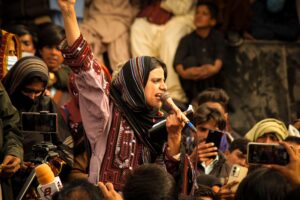Iranians Find Nothing to Celebrate
Despite a government offer of partial amnesty, the “Woman-Life-Freedom” protests continue. A protester with an Iranian flag painted on her face participates in a torchlight procession in honor of the Nobel Peace Prize laureates in Oslo, Norway, Saturday, Dec. 10, 2022. (AP Photo/ Markus Schreiber)
A protester with an Iranian flag painted on her face participates in a torchlight procession in honor of the Nobel Peace Prize laureates in Oslo, Norway, Saturday, Dec. 10, 2022. (AP Photo/ Markus Schreiber)
It is tradition in the Islamic Republic of Iran for the Supreme Leader to mark the anniversary of the 1979 revolution with a symbolic prisoner release. The commutations occur during the extended celebration leading to the Feb. 11 anniversary. This period, known as the Ten Days of Fajr, features official events across the country, including a well-regarded film festival.
This year’s official amnesty was larger than usual, arriving as it did in the midst of the nationwide uprising sparked by the murder of a Kurdish-Iranian woman, Mahsa Jina Amini, at the hands of the Morality Police in September. During five months of protests, at least 20,000 Iranians have been incarcerated and more than 500 have been killed in the state’s crackdown.
If the regime believed its ritual amnesty offer would defuse tensions or mollify the public, it was mistaken. During the official Fajr celebrations, protesters across Iran burned government banners in a clear rejection of the strategy to weaken their resolve with partial amnesty. The fireworks that burst over Tehran on Saturday evening were accompanied by chants of Woman Life Freedom ringing out from rooftops, and the state television broadcast of the president’s speech during the day’s celebrations was interrupted by hackers with the slogan Death to the Dictator.
Although details of the pardon are still hazy, they would not extend to those accused of the crime of moharebeh, or “waging war against God,” which is the charge hanging over 18 protesters threatened with execution. (Four protesters have been executed on these grounds in the past two months.) An official statement by the head of the judiciary, Gholam-Hossein Mohseni Ejei, highlights that the commutations would target young people who have expressed “remorse for their actions” or confessed to “being led astray by foreign powers.”
So limited are the terms of the pardon, it can only be seen as a transparent attempt to bolster the regime’s narrative that the protests have been quashed, that the protesters are puppets of foreign regimes, and that those who have taken to the streets are now repentant. If anything, the offer has only hardened the protesters’ resolve by acknowledging the scope of the imprisonment: the regime’s official announcement mentions tens of thousands of potential pardons. Until now, all arrest estimates have come from human rights groups; this is the nearest yet to an admission of the great numbers being held.
The rejection of the pardon was articulated by many celebrities, actors and film directors, who collectively spoke for their colleagues currently in prison for supporting the protests. Prominent members of Iran’s film community, such as the director Mani Haghighi, have made social media statements rejecting the Minister of Culture’s call for their participation in the Fajr Film Festival. This continues the public role that Iran’s film community has taken throughout the protests. When Taraneh Alidoosti, one of Iran’s top actresses, was arrested for posting a picture of herself without her headscarf in solidarity with the protests, a group of Iranian filmmakers held a vigil outside Evin prison every day until she was released. When she emerged from Evin prison greeted by her friends, Alidoosti was not wearing a headscarf.
If the regime believed its ritual amnesty offer would defuse tensions or mollify the public, it was mistaken.
Amid the ongoing protests, the country is grieving the many young people who have been killed, arrested and tortured. Since September of last year, the full force of the Iranian regime’s security apparatus has been used against the protesters, including systematic torture and rape. Many young people have committed suicide upon release. Doctors and lawyers providing assistance to the protesters have also been targeted by the authorities, and many injured protesters do not dare go to hospitals for fear of being arrested.
To help fill this void in medical care, Iranian medics in the diaspora have made themselves available online and advised protesters on dealing with their injuries. The risks of providing this assistance on the ground are real. Three medical professionals who traveled to Kurdistan to treat protesters and provide necessary medicines were arrested, tortured and charged with acting against national security. Doctors and nurses in Iran who have treated protesters report that security forces target women protesters’ faces, genitals and breasts, while male protesters are generally shot, often at close range, in the legs and arms, sometimes with live ammunition, sometimes with bird pellets that have blinded many. In late January, Kosar Khoshnoudikia, a member of Iran’s national archery team, released a video describing how she lost an eye at a demonstration in the western city of Kermanshah.
While pictures on social media show women going about life without their headscarves, these signs of shifting mores represent small and incomplete victories. Most of these photos are taken in areas where the regime and its cronies live, such as the affluent areas of northern Tehran. They do not represent the rest of the country, especially the more conservative, poorer neighborhoods and regions. Even if the regime were to loosen national hijab laws, which it has not done, it would not come close to satisfying protester demands, which include the end of the Islamic Republic. We must beware of conflating these social media images with real change as the regime continues to brutalize prisoners and arrest protesters and anyone supporting them.
Nor does the crackdown show meaningful signs of abating. Parliamentarians have drafted a bill that seeks to curb “unprofessional comments” posted on social media by influential figures, including celebrities. The proposed legislation prescribes prison terms of up to 15 years and fines for those found guilty. Critics have labeled the proposed legislation the “suffocation bill,” another weapon in the regime’s armor against dissent.
But there are hopeful signs of more meaningful change. Inside Iran, former reformist politicians have started to call, however tentatively, for ending, not reforming, Iran’s ruling government. A well-known reformist and former presidential candidate, Mir-Hossein Mousavi, has called for a “free” referendum and demanded a new constitution based on the Woman-Life-Freedom movement. This is the first time that regime change has been mentioned, however obliquely, by anyone within Iran’s political establishment. In spite of his house arrest, the 80-year-old Mousavi is still seen as a lead reformist figure, and his position that the system cannot be reformed is recognized as a threat by Iranian authorities who have attempted to discredit his remarks by claiming he is affiliated with the People’s Mojahedin Organization, a hated opposition group in exile. But the strategy is not working, and other jailed reformist politicians have started to echo his call.
While the regime attempts to turn back the clock to “business as usual,” distracting the population with celebrations and propaganda, the people of Iran continue to make their fury felt, particularly in the regions of Kurdistan and Baluchestan where protests and the crackdown have been most fierce. A freezing winter is sweeping across Iran and gas shortages mean daily blackouts for many in this oil-rich country. The economic crisis, widespread corruption and repressive laws that led to the uprising continue to fuel the people’s rage. As this year’s Fajr Film Festival draws to a close and the nominees for the Simorgh prize (Iran’s Oscar) are announced, Iranians are refusing to celebrate.
“You cannot force someone’s head under water and then demand that they not move their hands and feet,” said filmmaker Mani Haghighi in a video statement to culture minister Mohammad Mehdi Esmaeili. “And now you want that same person to sing for you and make a film for you to show in your festivals. We are in mourning. We are obliged to visit our friends in prison. In the four corners of this country, we are burying our loved ones. We do not have time to dance for you.”
While pictures on social media show women going about life without their headscarves, these signs of shifting mores represent small and incomplete victories.
Last week’s Grammy Awards cast an unexpected spotlight on another Iranian artist to emerge as a prominent voice of the protests. Iranian singer-songwriter Shervin Hajipour won the inaugural Best Song for Social Change Special Merit Award for “Baraye,” a viral Instagram hit that racked up 40 million views in 48 hours and quickly became the anthem for the Woman-Life-Freedom protests.
Controversially, the award was presented by First Lady Jill Biden, muddying the politics around the song and compromising Shervin’s safety in Iran. Immediately following the presentation, the 25-year-old singer took to social media to state his love for Iran and intention to remain in the country — as well as to pointedly lament the fact that the award was presented by the wife of the U.S. president, rather than someone from the arts.
The controversy also distracted from the substance of Shervin’s heartrending song of freedom, composed from simple but moving tweets by Iranians about their reasons for protesting. Shervin was arrested upon the release of “Baraye” — meaning “Because of” — and an international social media campaign around the song may have saved his life. Now free on bail, he remains charged with “propaganda” and “inciting people with violent acts,” under threat of imprisonment and a possible death sentence.
Banned from leaving the country, Shervin was unable to pick up his award in person, or even release an acceptance video. But scenes circulated online show him watching the announcement on television and wiping a tear from his eye, overwhelmed by emotion. A bittersweet moment — while for now Shervin is free, many other musicians in jail face torture for their support for the protests, namely rapper Toomaj Salehi who, after more than 100 days of imprisonment is reported to need urgent medical care, and Kurdish rapper Saman Yasin who has been sentenced to death and tried to commit suicide in prison in December.
On the 44th anniversary of the revolution, in spite of the regime’s attempted show of triumph and munificence, the people of Iran sang “Baraye” from their rooftops, their simple desires cutting through the sham of the regime’s narrative:
Because of dancing in the street
Because of fear while kissing
Because of my sister, your sister, our sisters
Because of the changing of rotten minds
Because of shame for not having money
Because of the yearning for an ordinary life
Because of the scavenger kid and his dreams
Because of a failed economy
…
Because of woman, life, freedom
Your support matters…Independent journalism is under threat and overshadowed by heavily funded mainstream media.
You can help level the playing field. Become a member.
Your tax-deductible contribution keeps us digging beneath the headlines to give you thought-provoking, investigative reporting and analysis that unearths what's really happening- without compromise.
Give today to support our courageous, independent journalists.






AMAZING how still in the 21st Century can such a backward, religious, fanatical government exist. How can a country that offers so many cultured and evolved individuals have such a backward, savage leadership in government?